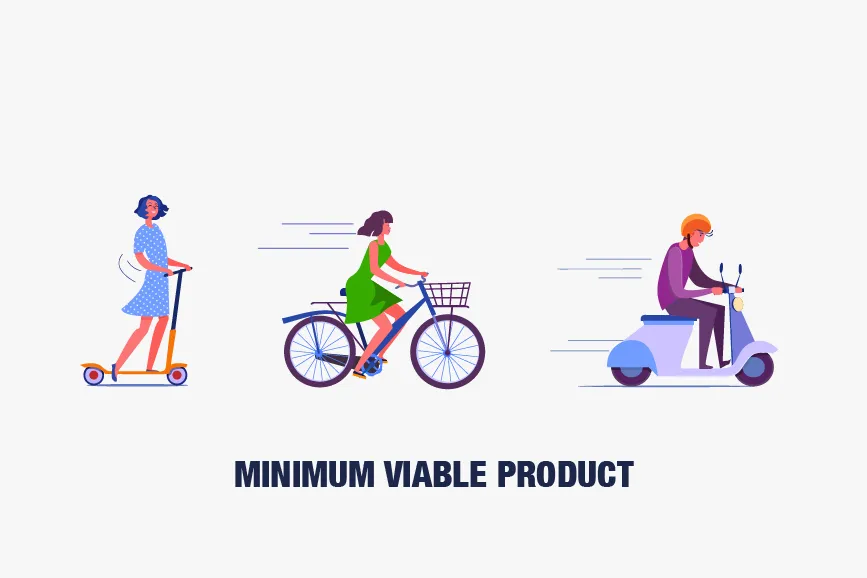According to statistics, up to 45% of startups fail due to inaccurate study of the market needs and product capabilities, as well as the late introduction of solutions to the market arena. Even an initially good idea needs to be thoroughly checked and, if necessary, edited. This is why a truly successful product is impossible (or pretty challenging) to achieve without timely MVP development.
In this article, in-depth tech experienced Owlab specialists shed light on how to build a minimum viable product that will help you enter the market with a bang, grow, and succeed in the long run.
What is an MVP?
A minimum viable product is an early version of the product, which has a basic, but sufficient set of features to start using a new solution. With a timely created MVP, developers aren’t swamped with lengthy and unnecessary work burdens from the get-go, while end-users may provide feedback for future product refinement. MVP is a prototype of a conceived full-fledged product. Technically, this is the product with the highest return on investment (ROI) that helps kick things off and avoid many common pitfalls.
Purpose of Сreating an MVP
Understanding that a product or service will be in demand is the main condition for a successful business project. In our opinion, it is necessary to build an MVP to:
- Make sure that the potential users need the future product;
- Better satisfy the target audience;
- Get feedback, assess the need for improvements, and set priorities straight;
- Understand the optimal direction for the further development of product iterations;
- Attract the initial user base and start monetizing the product;
- Cut development time and costs by filtering out unnecessary functionality at the development stage.
The main goal of creating MVP is to test the viability hypothesis and get feedback from users. To see the real picture, you need to individually approach the development of the “prototype”. However, it needs to be created as quickly as possible, at the smallest possible investment, and it should include only the most crucial functions (the user need for which should be checked and approved).
Benefits of Minimum Viable Product Development
The timely creation of an MVP gives a range of advantages to businesses, especially to startups. Let’s take a closer look at them.
Focus on core functionality
Having an MVP in hand helps you focus on core features and test your business concept at a minimal cost. Releasing a product version without redundant functionality allows you not to lose focus on the specific problem.
Early testing opportunities
Flaws and errors that may not be visible at the initial stage of development can be easily pinpointed in an MVP. Thus, you gain momentum and spend less money on costly reworks of the finished product.
Feedback from users
The initial users help shape the demanded end-product by sharing opinions and reviews of the core functionality. This makes the finished solution completely user-focused and directly required by the target audience.
Market validation
You get to validate the product viability and make necessary changes in time. The development requires a minimum number of features to test and some time to implement the idea.
Faster time-to-market
MVP is all about a fast launch, after which you can test the product at the initial stage and quickly get the feedback needed for further development and release. This ultimately cuts time to market.
Budget-friendliness
A minimum viable version of the product costs much less, but it effectively helps to attract new users and investors at the initial stage of development. On top of that, you can start making profits early on and save on market and target audience analysis.
How To Build An MVP In 5 Steps?
So, let’s discover how to create MVP. The first thing to determine is which tools, features, and capabilities are crucial to the project. There is always room for improvement and perfection, but keep in mind that the Pareto rule still works. Almost 80% of your customers will use only one-fifth of the implemented functionality. This is why it is so important to focus on them. To do so, do the following.
Define a problem statement
Clearly state the idea of the product and the hypothesis about its need for potential users. Start by identifying the problem to be solved. In a few words, clarify the question: who needs a new product and why. Validating an idea early in development is important to conserve resources and make sure your solution is demanded.
Conduct market research
Before you learn how to build MVP, study the market and competitors, determine your target audience, and calculate the market size. You must understand exactly the real market value of your product. Conduct a SWOT analysis to identify strengths, weaknesses, opportunities, and threats for the future product. If necessary, use paid reviews on popular expert platforms.
Choose the must-have features

Designate the criteria that determine the viability of the product. Scoring reviews is critical, and you should start collecting them as soon as possible. Based on the responses from potential clients, create a checklist and a roadmap for the implementation of vital functions.
Verify the idea with a prototype
Develop and launch a prototype as quickly as possible. Collect regularly in every possible way and critically process the information received through feedback. Calculate and evaluate key performance indicators and make sure they are in line with what is estimated/expected.
Build and improve
The research and analysis should not cease once the development kicks off. It must run in parallel. Make the conclusions about the performance, user-friendliness, and marketability of your solution and move on to testing the next iterations. Your goal is to offer a product with basic features to test market fit and get better results.
Possible Mistakes in MVP Development Process
It is difficult to get a decent product right away with minimal loss of time and money. Lack of experience, competencies, and knowledge inevitably leads to mistakes, which then have to be corrected. In any case, you can understand what you shouldn’t do at all. Here is the list of the most common pitfalls for you.
Wrong choice of problem to solve
A successful product must meet the needs of the target market. If this is not there or the product solves some other problem that’s beyond the TA’s scope of focus, then the idea, most likely, won't hit the demand and demonstrate the viability.
Skipping the prototype phase
MVP is a kind of prototype of the final product, but it also needs some prototyping of its own. You cannot start a project without an idea of what it will look like. For this, developers sketch out a couple of design versions. Thus, ideas can be easily rejected, changed, or adapted. This is a great way for developers to better understand the mechanics of a product. Further changes are much more difficult and expensive to implement.
Choosing the wrong segment of the target market
Targeting a wide audience is unlikely to lead you to success. Create a narrow user profile. Even if you know how to create an MVP that fits your project, you cannot start without defining the characteristics of an ideal client who will buy your product without hesitation and be satisfied.
Feedback received from end-users helps improve and adapt the product according to real needs. Outline user personas with information about the age, education, income level, habits, interests, and hobbies of target users. They will also help you launch an efficient advertising campaign.
Inappropriate development method

Choose the option that provides flexibility and replicability. For instance, the very traditional Waterfall method is not well suited for MVP creation, while agile development is usually more efficient and successful. The product gets to market faster and is more adaptable as continuous and iterative growth is prioritized.
An imbalance between qualitative and quantitative feedback
Once you introduce your MVP to the public, you will start to receive feedback from users that cannot be ignored. Consider qualitative feedback as well as quantitative. Focusing on one thing is a mistake. For example, a business cannot choose profitability over liquidity, or vice versa, without failing.
Choosing one type of feedback will leave users unsatisfied as there is a high chance of missing out on valuable information about what they need and want from the product. It is necessary to use all available criticism of potential customers. If they do not feel that their needs are being met, they won’t choose it.
Now you know how to build a minimum viable product. By doing so, you can avoid developing unnecessary functionality that won’t be valuable to the end consumer but will waste your resources.
It doesn’t matter what product, at what scale is planned to be created. Working on a prototype pays off because it helps not only to identify strengths and weaknesses but also to reduce possible risks. Of course, you will need the appropriate competencies for this.
If you need to create an MVP, contact our specialists and kick off a guaranteed successful project by joining forces with a reliable partner!